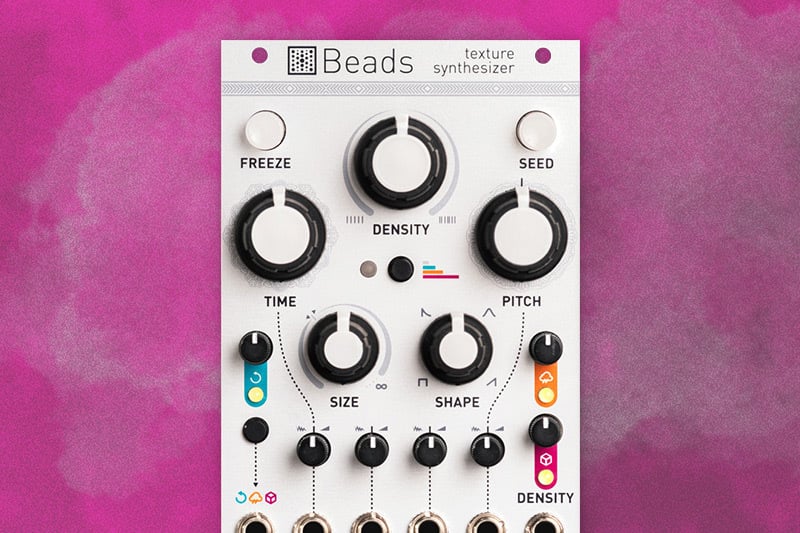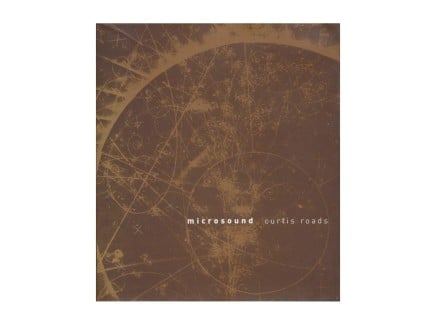After years of anticipation, the day has come: Mutable instruments has given us Beads, the direct successor to their much-loved Clouds Texture Synthesizer. Focused on extending the possibilities of the original and refining its overall user experience, Beads is a next-generation evolution of one of the most ubiquitous Eurorack modules ever.
Of course, living up to the expectations established by a module like Clouds is a challenge. Émilie Gillet has proven once again, though, that she is tremendously creative and industrious, providing a module that promises to bring inspiring new sound design capabilities to a huge range of Eurorack systems. Let's take a look at what this module is all about, and see how it compares to its predecessor.
The Slow Embrace of Hardware Granular Synthesis
To understand how significant a development Beads truly is, we first need to look back a few years, to the early 2000s. We've discussed the narrative of electronic music instrument development in the 1980s / 1990s / 2000s several times, but it's worth revisiting. In the early 2000s, the sounds of analog synthesis had become popular once again after falling out of vogue in the late '80s. Many instrument developers (Clavia, Korg, Roland, Yamaha, Alesis, etc.) had begun to produce "virtual analog" instruments that emulated the workflows of older synthesizers, and brave companies like the newly-re-established Moog Music were bringing fully analog synthesizers back into production. We know the history from there: demand for true analog synths and hybrid synths grew considerably, until we reach the current day, where analog, digital, and hybrid designs are all well-represented.
That part of the story is fairly neat, tidy, and well-known at this point. However, much more was happening at that time. One of the more interesting and less-explored histories of the time surrounds the development of computer music and new digital synthesis techniques—many of which are still considered novel in the world of hardware instrument design. One of the "hot topics" in computer music in the early 2000s, of course, was granular synthesis. With the publication of Curtis Roads's Point Line Cloud and the seminal text Microsound, granular synthesis as a technique felt like it suddenly had come into its own. Point Line Cloud became a go-to example of how engrossing granular synthesis could be, and Microsound provided the conceptual framework that would allow composers to finally wrap their heads around how it worked, and how they might use it.
We dove more deeply into the topic in this article, but in a nutshell, granular synthesis is the process of composing sounds by creating dense clouds or continuous strings of tiny sonic fragments—usually 100 milliseconds or less. These sounds may be electronically generated, or may be fragments of recordings of acoustic sound sources.
The thing is—granular synthesis isn't at all a new synthesis method. Its principles were already in place as early as the late 1950s / early 1960s in the work of Iannis Xenakis, and it was first implemented in the computer domain decades ago. The important thing to note is that in the 1970s and 1980s, the process of executing granular synthesis was extremely resource-intensive: home computers did not yet exist, and it required highly specialized and prohibitively expensive equipment to perform. As such, despite the fact that this form of synthesis was of growing interest in academic settings with mainframe computers and lots of research funding, it wasn't yet possible or practical to put these capabilities in a commercial device.
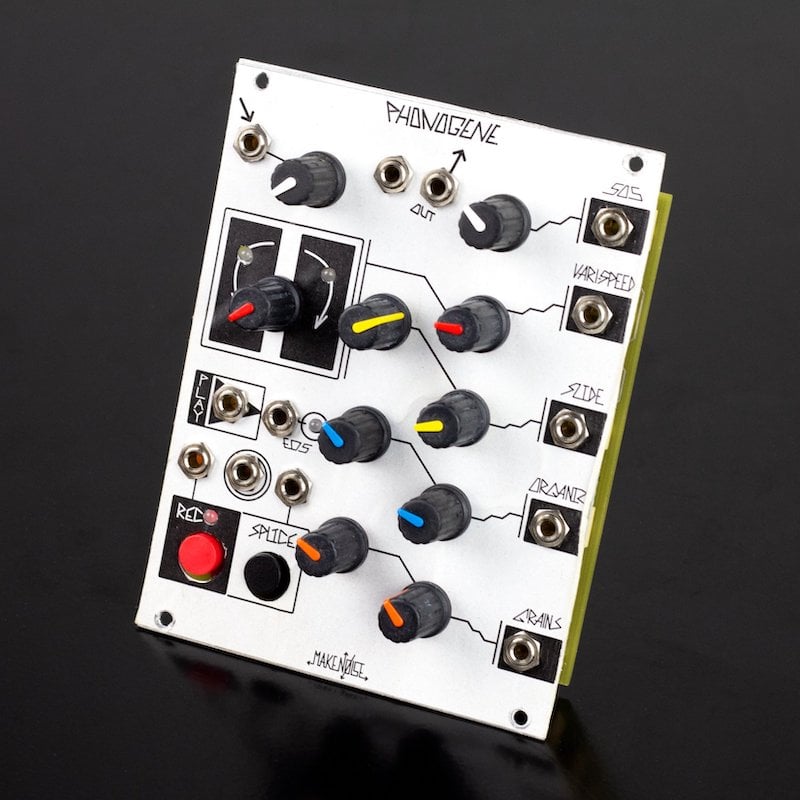
It took a few years before hardware developers fully dove in and started developing devices with this synthesis framework at their core, and it's still quite rare to see granular synthesis surface in mainstream designs (with exceptions like Waldorf's Quantum). Interestingly, the first people to embrace the technique weren't large manufacturers: they were niche instrument builders like Gotharman (Deformer), The Harvestman (Tyme Sefari), and Make Noise (Phonogene)...the latter two of which developed devices specifically for use in Eurorack modular synthesizers. The Eurorack format has proven one of the most adventurous gear formats for exploring new sonic capabilities—these companies are often led by a very special type highly creative and intelligent oddball who values the pursuit of unexplored musical territory. The evolution of granular synthesis in the Eurorack format surely is proof of this.
Make Noise's Phonogene is an excellent example of how many hardware implementations of granular synthesis worked at first. Though it is implemented digitally, in a way you can think of Phonogene as containing a continuous reel of tape with sound recorded onto it. You have the ability to speed it up, slow it down, and to divide the tape into small segments (Genes) which can be selected and navigated between using onboard knobs or external CV. By dividing the recorded sound into sufficiently small genes and repeating them, you get a choppy, glitchy sound. Playback of these genes is strictly monophonic—that is, only one gene plays at a time, with no overlap. This is typical of a particular style of granular synthesis, and lends itself to a "Roads-ian" technique called micromontage: the juxtaposition of many small sounds in succession to create an animated and very articulate gesture. While being able to work with sound in this way in real time on a hardware device was absolutely revolutionary, its monophonic nature couldn't account for many other granular techniques.
Polyphonic Granular Synthesis in Clouds
Released in 2014, Mutable Instruments Clouds was one of the earliest hardware devices in modular format to exploit the possibilities of polyphonic granular synthesis methods. Unlike Phonogene, which could only play a single grain at a time, Clouds could generate up to 60 simultaneous grains. By allowing old grains to continue to play out while new grains were generated, Clouds provided access to a much more textural approach to granular synthesis. While Phonogene and others were excellent for gestural micromontage, Clouds quickly became a go-to for creating, er, clouds of intricate, animated sound.
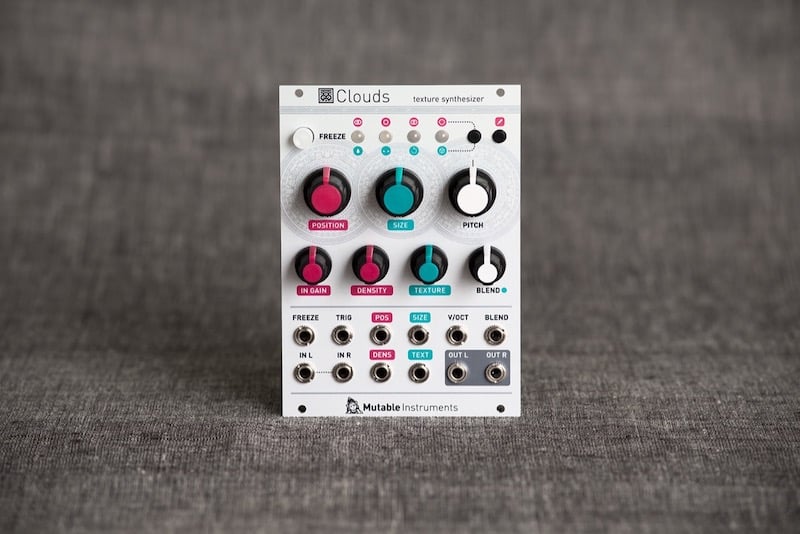
Again, this was a groundbreaking development: Clouds provided possibly the most fully-featured and immediate approach to Cloud Synthesis and Pulsar Synthesis ever available in hardware form. By offering immediate access to high-level controls for grain size, grain position within recorded buffer, grain pitch, and grain envelope shape (texture), Clouds made it easy to create a huge range of sounds. Using the dual-purpose density knob (which allowed for both periodic and irregular creation of new grains), everything from stuttering glitches and discontinuous jarring textures to smooth, washy textures became easily possible. The four blend modes (which each shared a common knob) allowed for wet/dry mix adjustment, random panning on new grains, feedback, and the addition of an end-of-chain reverb effect.
One of Clouds's most important features was its ability to granularize incoming audio in real time. Most prior implementations required recording sound into a buffer and then manipulating that buffer separately from the original sound. By "Freezing" the buffer, Clouds could operate in this way as well—however, its default behavior is to continuously record incoming audio and perform granular manipulations on the ever-evolving buffer, making it like something between "traditional" granular synthesis effect and a delay or reverb.
By extensively modulating each of its parameters, Clouds could turn any sound source into something completely new. Simple tones could evolve into engrossing stereo textures, and acoustic instruments could generate their own textural accompaniments in real time. Even without modulation, even a modest Eurorack system was suddenly capable of creating huge, evolving masses of sound. This is what made Clouds so popular—and in some ways, what led to its demise. When a musical tool has such a distinct sonic signature, it becomes easy to lean on it for a substantial part of your music's character...and when it will do something so engrossing when simply left to its own devices, many users will not feel driven to explore it fully.
Because there are so many Clouds modules out there, for a while, modular synth music became very homogenous—it felt like every new track or YouTube video that came out had a nearly identical wash of lush ambient sound. And while that sound is beautiful, after a couple of years, it had lost a lot of its novelty and became a bit more difficult to appreciate. It seemed as if Mutable Instruments felt the same way. In an announcement in October 2017, Émilie Gillet addressed her own struggles with the life the module had taken.
"By the end of 2014 I was tired of the project, wanted to be over with it, so I decided to have 250 Clouds manufactured, which I hoped would simultaneously be the first and last batch. I predicted it would have the same destiny as Edges – something that a few people would totally get and love… and that would go unnoticed by the rest...and then, in what could be seen as a very meta plot twist, the deity decided to use Clouds to process all the beliefs and perceptions surrounding the module, got confused with this damned BLEND knob, feedback and reverb got stuck to the maximum setting, resulting in a never-decaying smudgy howl of hype. And I felt awful about it."
She continued, explaining her frustration that most people seemed to use it as a simple end-of-chain reverb-like effect with no modulation, and that many had missed what she felt was the true point of the module. She ended the announcement with a hint of things to come: "Clouds has shown that live granular transformation is an important sound design tool in a modular system. There ought to be a distraction-free device to perform it. I’m currently building it."
Now, we finally get to see a more evolved form of this modern classic effect—one which takes many steps closer to her original vision: Beads.
Clouds Refined: Mutable Instruments Beads
Beads is Mutable's new take on the granular texture synthesizer concept, complete with expanded audio quality, extended buffer size, a more straightforward user interface, and an approach closer to the designer's original intentions. Since its discontinuation, people have constantly asked and speculated about when "Clouds 2" would emerge—and it would seem that today is that day. However, don't expect Beads to be exactly what Clouds was: though it technically does cover all the functionality of the original module, it's a significantly evolved design that is sure to take us into completely new territory.
First things first: Beads has significantly improved on Clouds's audio quality. Upgraded memory permits the use of longer buffers, and a significantly upgraded CPU offers an upgrade to many sample-rate rather than block-rate calculations, making it possible to create much more articulate and crisp sounds. It also offers four audio quality settings with a much broader timbral palette than the original. These include pristine digital sound reproduction, modes that emulate the character of abused cassettes, and even a mode that emulates Clouds's distinct sonic identity.
As before, Beads can continuously process incoming audio, or can "Freeze" a buffer to granularize a static sampled sound. Beads is parameterized quite similarly to its predecessor, with dedicated controls for Time, Size, Density, Pitch, and Shape. These correspond to the key granular parameters: position within buffer, grain size, the regularity at which new grains are produced (again, allowing both regular and irregular grain dispersion), grain pitch, and grain envelope shape. Additionally, Beads does away with Clouds's often-decried "blend" knob in favor of broken-out controls for wet/dry mix, feedback amount, and reverb amount. These parameters share an assignable CV input (which can be assigned to these parameters individually or in combination). This solves one of the biggest UI / UX "oopsies" of the original design—now that these parameters don't share a single physical control, it should be much easier to dial in your sounds, to visualize the overall state of the sound, and to even play these parameters simultaneously. That's going to make a huge difference in terms of playability.
One of Beads's other added niceties are "attenurandomizers" for Time, Size, Shape, and Pitch. These multi-function controls replace the typical attenuators/attenuverters that we know and love in favor of internal modulation. So, clockwise from 12:00, these knobs act as typical attenuators—however, left of 12:00, they add randomness to the parameter in question, introducing grain-by-grain variation that should make for considerably more intricate, detailed, and swarmy textures than easily possible on the original Clouds. When a CV is patched into these controls, it allows for CV control of the amount of randomness introduced...a clever concept that adds multifunction control to all parameters, similar to the behavior of the multi-function Density knob (which provides regular grain distributions counter-clockwise from 12:00, and irregular distributions clockwise from 12:00).
Of course, these features aside, Beads has added a host of new capabilities for control as well. It permits continuous grain creation (as with the original), but also supports gated granulation an clocked granulation, which produce bursts or grains or tempo-derived grains, respectively. The grain pitch can track 1V/oct, can track the pitch of incoming audio sources, and can of course respond to external CV. By cleverly setting your grain parameters, you can create a wide variety of delay-related effects (including pitch shifting delays). The right output can produce gate signals, and when no audio is patched to the input, Beads granularizes a bank of internal wavetables (borrowed from Plaits).
I have no doubt there are features I'm missing, and have no doubt that we'll discover many more uses and quirks once these are in our hands—but for now, we can live in an imaginative state and wonder just where this module will take us.
A Final Word
No doubt, Beads is a significant update to Clouds—one which addresses the designer's own issues with the original. Looking at the changes in feature set, I'm personally quite excited. As an owner of the original, I personally eventually did grow frustrated with some aspects of the user interface, and felt that over time, my personal uses of the module wound up only taking advantage of a small part of what it was technically capable. In the end, I found that I personally wanted something where all the controls were right in front of me, and where things could get a little bit more sonically crisp and defined. Though Clouds clearly has become a central part of so many musicians' music, I've talked with plenty of others who have the same issues...which always felt like a shame, given how powerful Clouds is on paper.
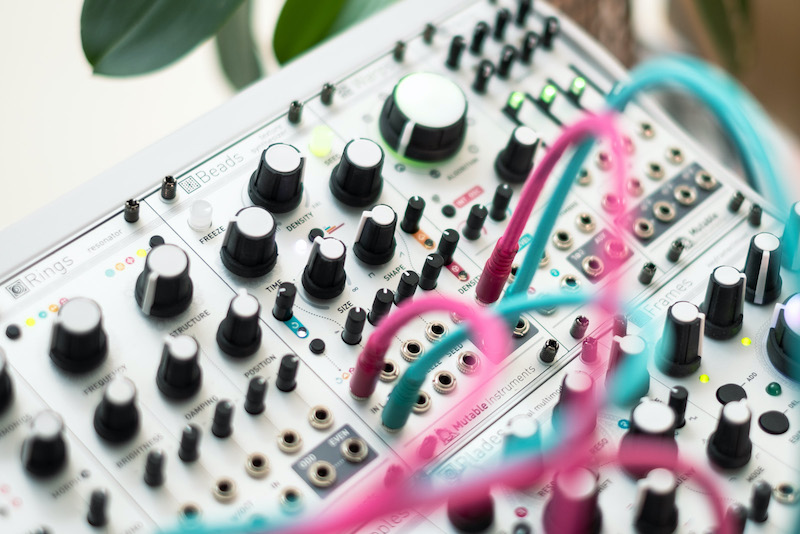
Beads has a significant reputation to live up to. The Eurorack world has been waiting for "Clouds 2" for years now, constantly positing what might change, and when it might come along. I'm happy to see all of the changes that Gillet has implemented. As with all of her other designs, Beads demonstrates a keen and constantly-evolving awareness of the importance of interface design. In the end, it seems that Beads features a host of remarkable innovations, with clear layout, smart parameterization, and (fingers crossed!) the ability to create an even wider range of sounds than the original.
Gillet has stated explicitly that Beads will be the final Mutable Instruments Eurorack module. And while it in some ways is sad to hear she will be parting from this corner of the music world, this feels like an appropriate and exceptional parting gift. She's given us a tremendous amount of her effort and creativity across the last several years. The world now has many more inspired and creative people drawing music from her creations, and I can't help but feel that the electronic music world is a good bit more colorful for her involvement in it. Even if Beads is indeed the last device she contributes, she has already had an enormous impact on the way that so many of us make sound and music. A large debt of gratitude, and best wishes to you, Émilie: thanks for Beads, of course, and thanks for providing us so much inspiration in such a short amount of time.

